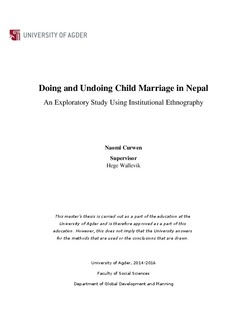| dc.description.abstract | Child marriage is a practice that occurs across regions, cultures and religions. Every year approximately 15 million girls under the age of eighteen get married. The practice often has serious impacts on the lives of the girls themselves, and child marriage threatens the progress in six out of eight development goals related to education, health, poverty and gender equality. The main drivers have been identified as tradition, poverty, gender norms, security and weak law enforcement, but despite available research a lot more remains to be understood about child marriage. The thesis does not theorise about why it happens, but explores the actualities of the doing and ‘undoing’ of child marriage in two districts of Nepal, Surkhet and Kapilvastu. The study is inspired by a method of inquiry called institutional ethnography (IE), which challenges how mainstream sociology clamps a theoretical framework over any inquiry, and how this determines how the actual world will be attended to. IE promotes a different understanding of the social as people’s coordinated activities, and the research starts out in lived life instead of theory. The thesis is a discovery into social research itself and seeks to explore what an alternative sociology might add to the understanding of child marriage. Using an IE perspective creates an understanding and appreciation of the complexity of people’s experiences. What I found is that the reality is much more complex than what an understanding of child marriage as the result of poverty, tradition or gender norms offers. Using so-called work knowledge as data gives a more detailed account of what the practice of child marriage actually entails for the people involved. It opens up for descriptions of activities that might otherwise not have been included. Further, the aim of IE is to explore how people’s activities are embedded in and shaped by trans-local relations. Not viewing child marriage as socially organised risks assigning causality or agency to concepts such as gender norms or tradition, which obscures what actually goes on. Additionally it risks blaming the practice on people and their characteristics, which maintains typologies and stereotypes. | nb_NO |
